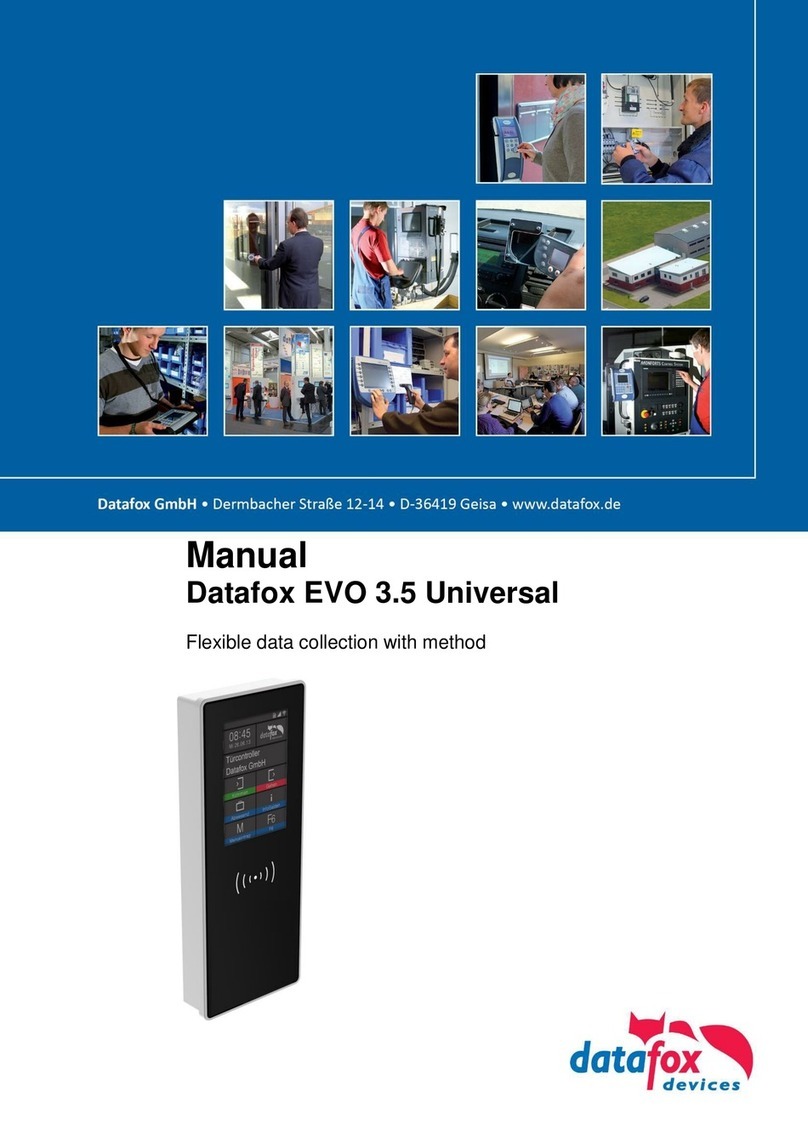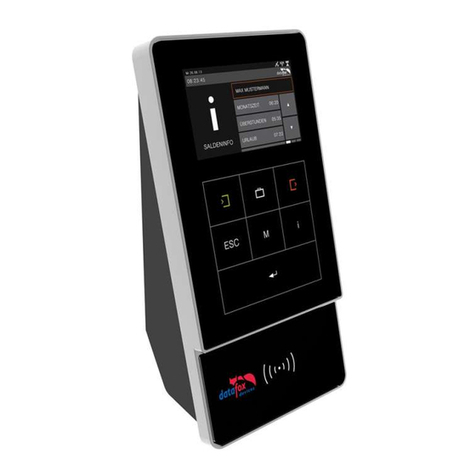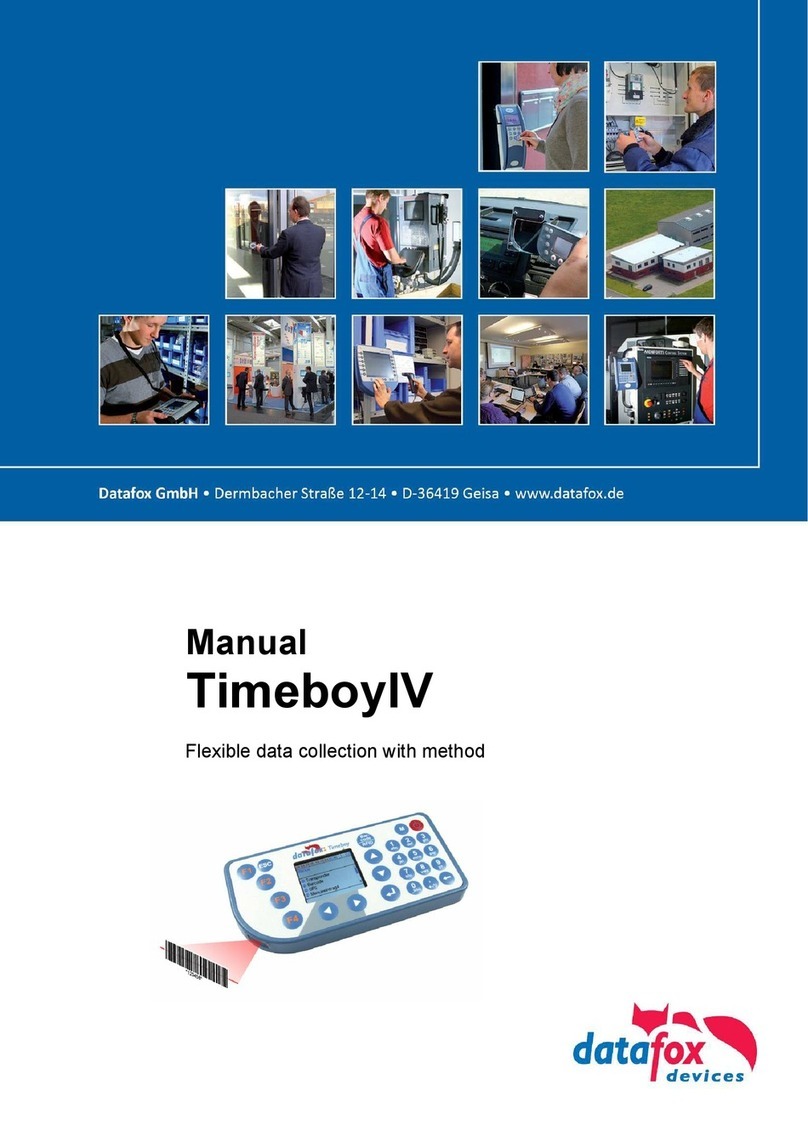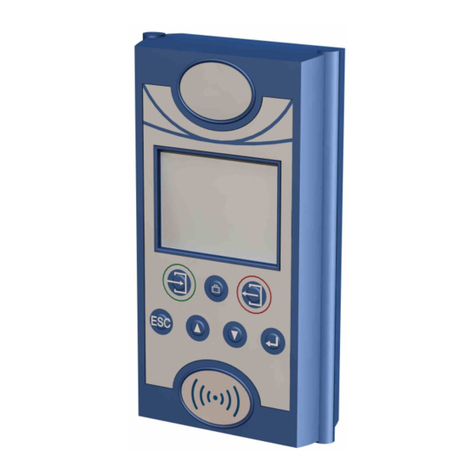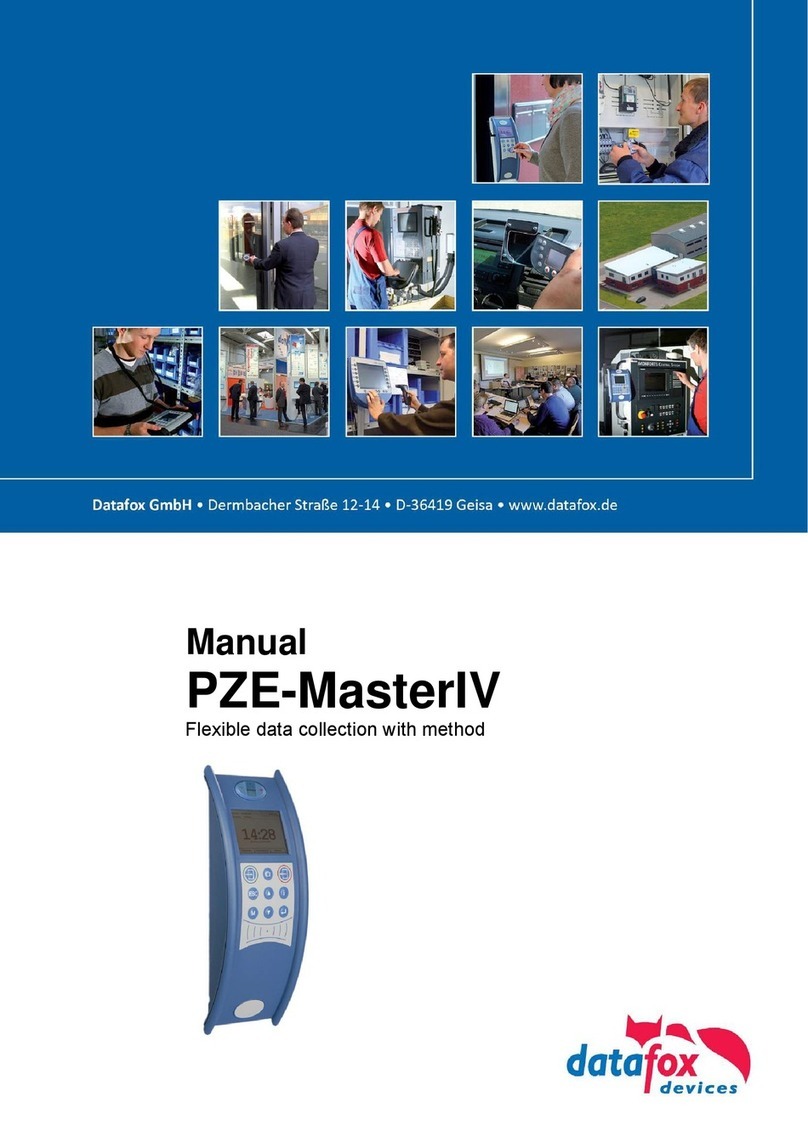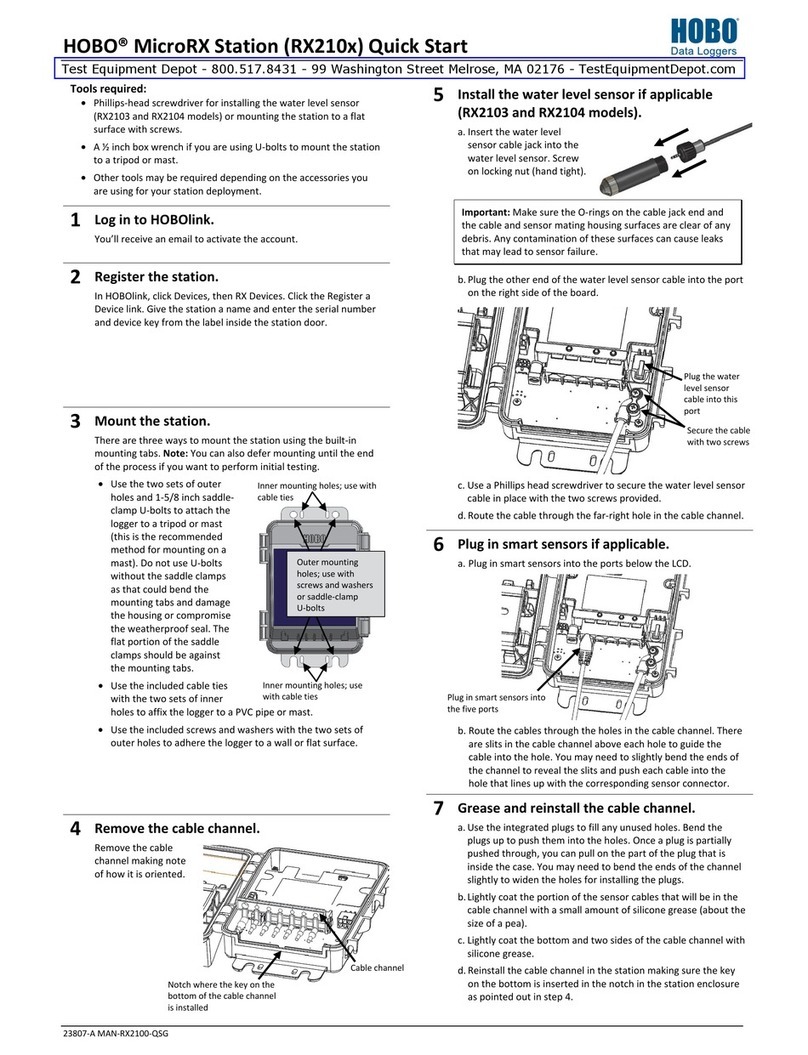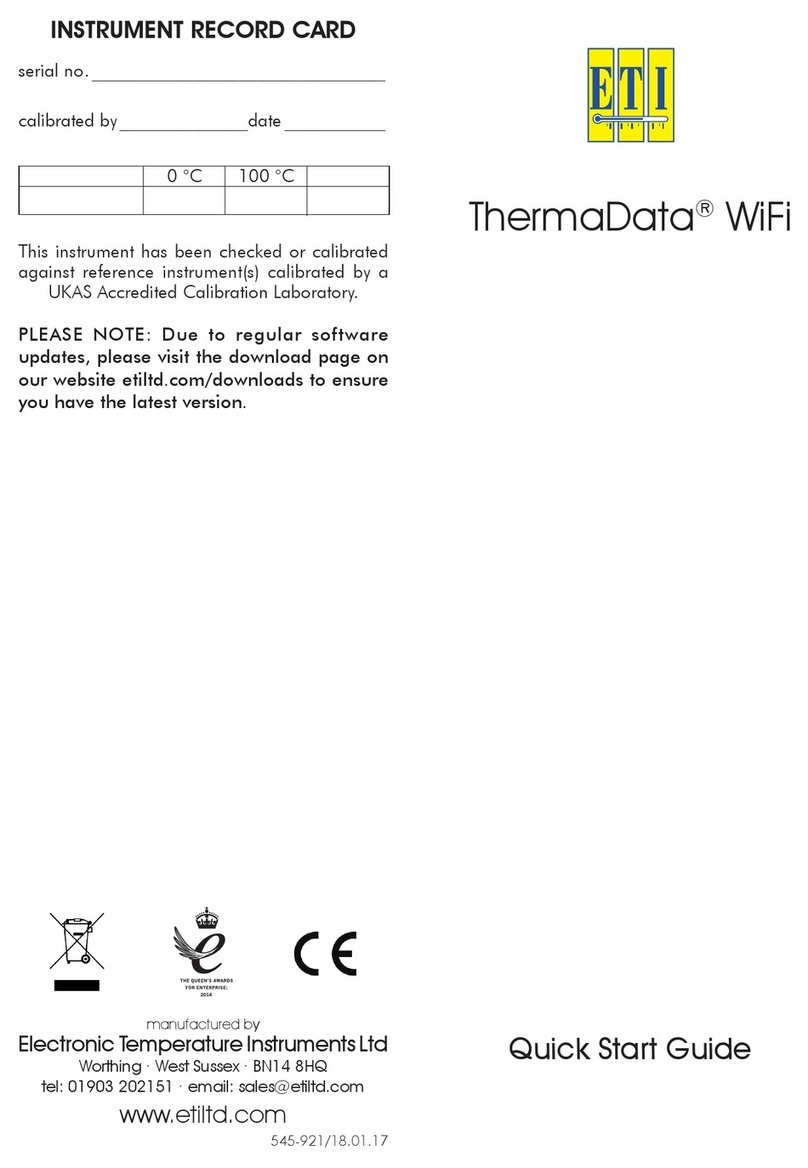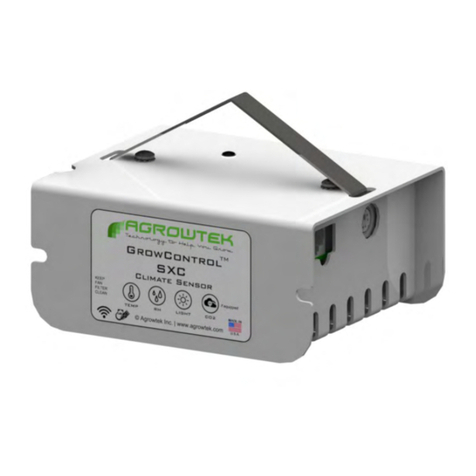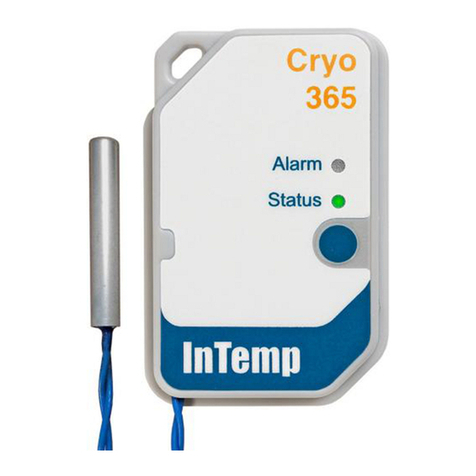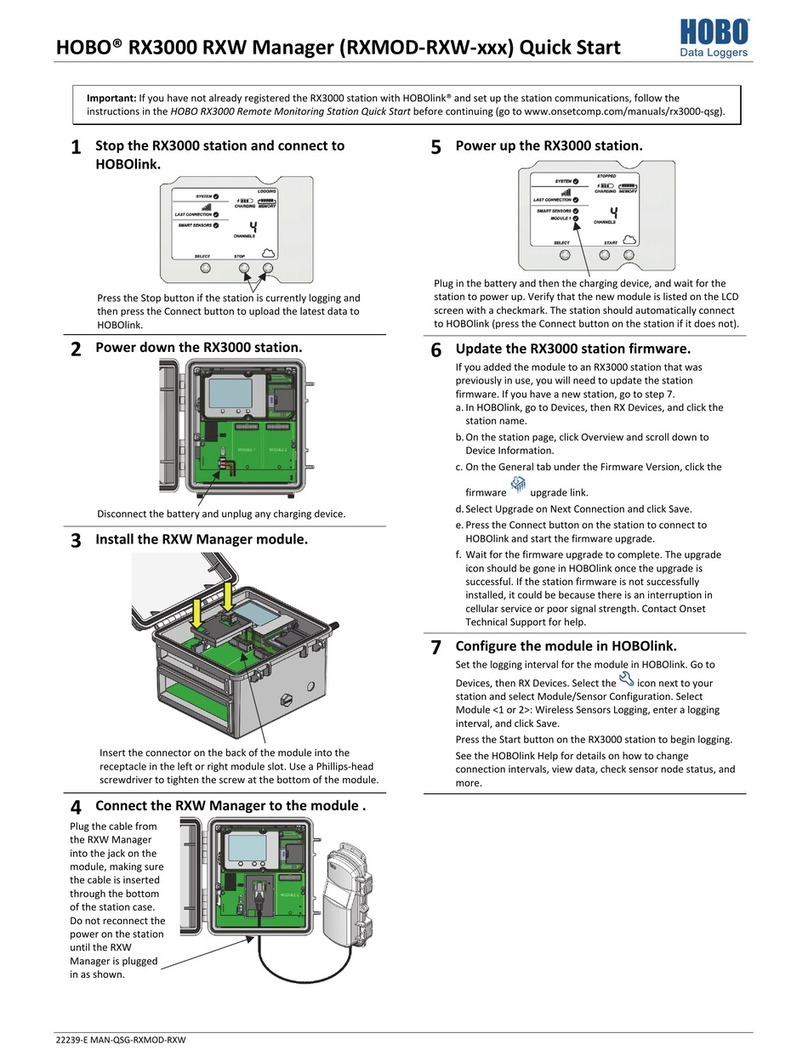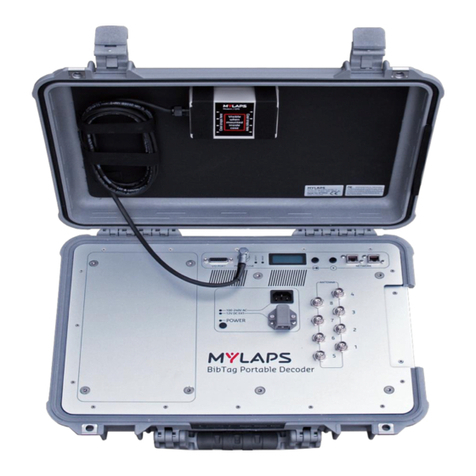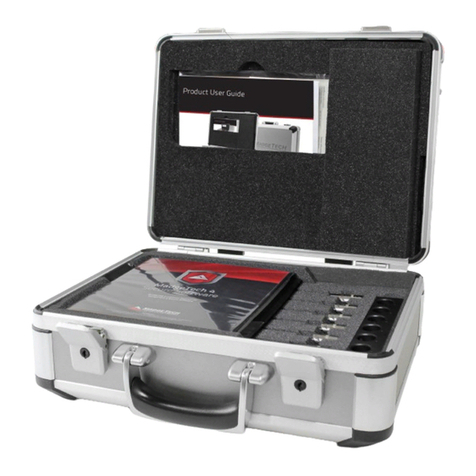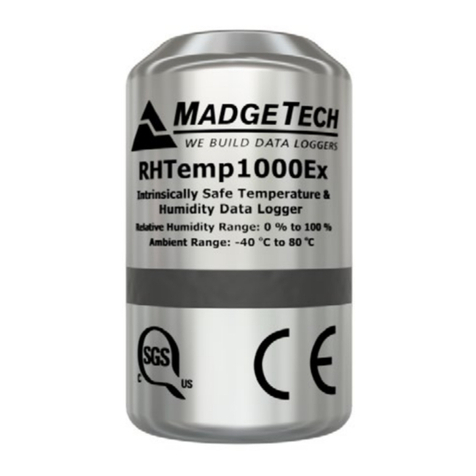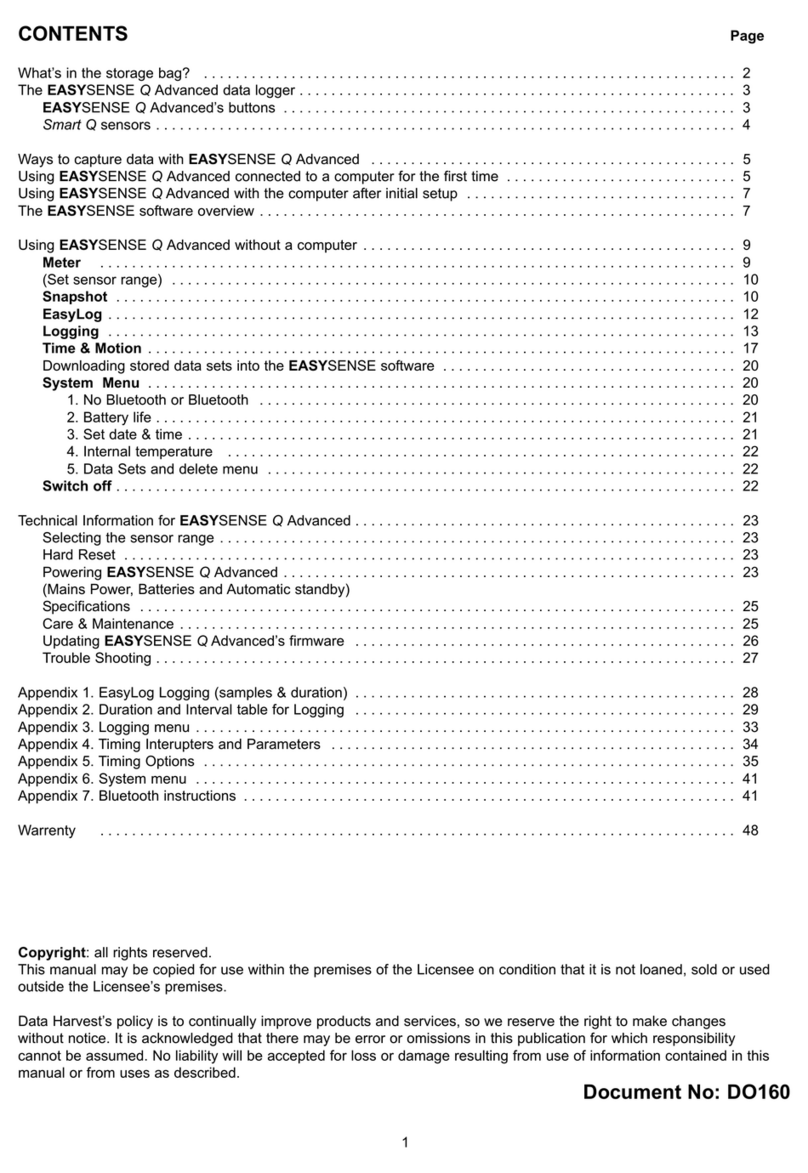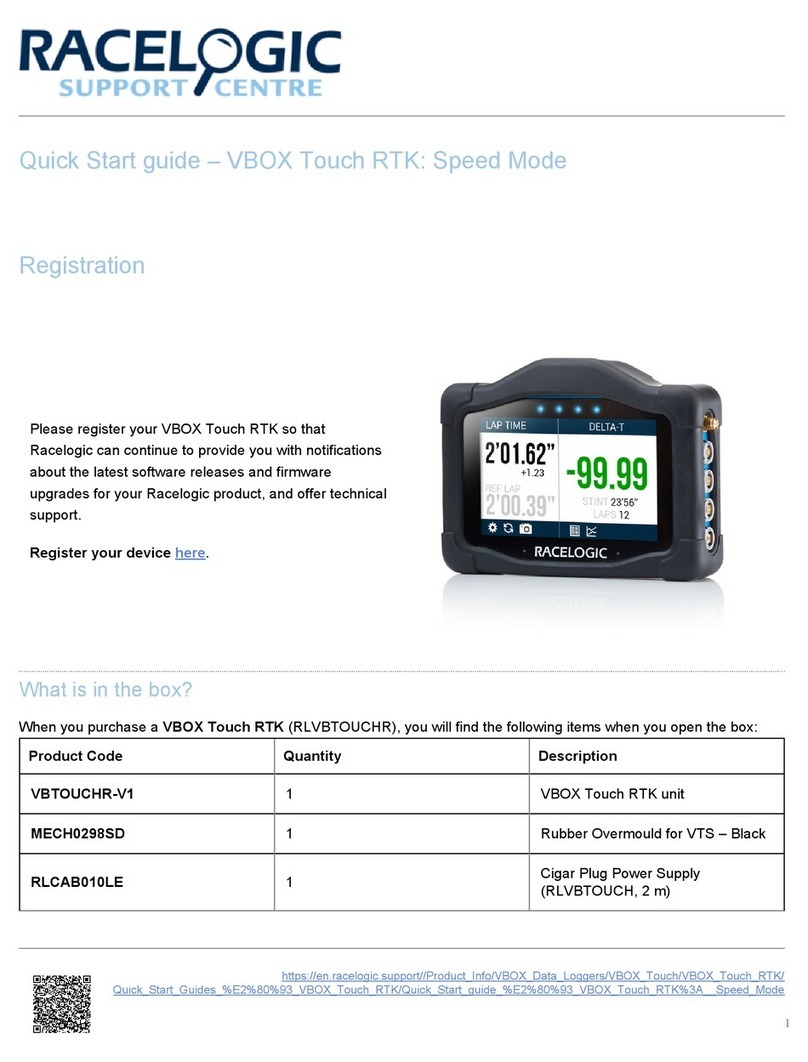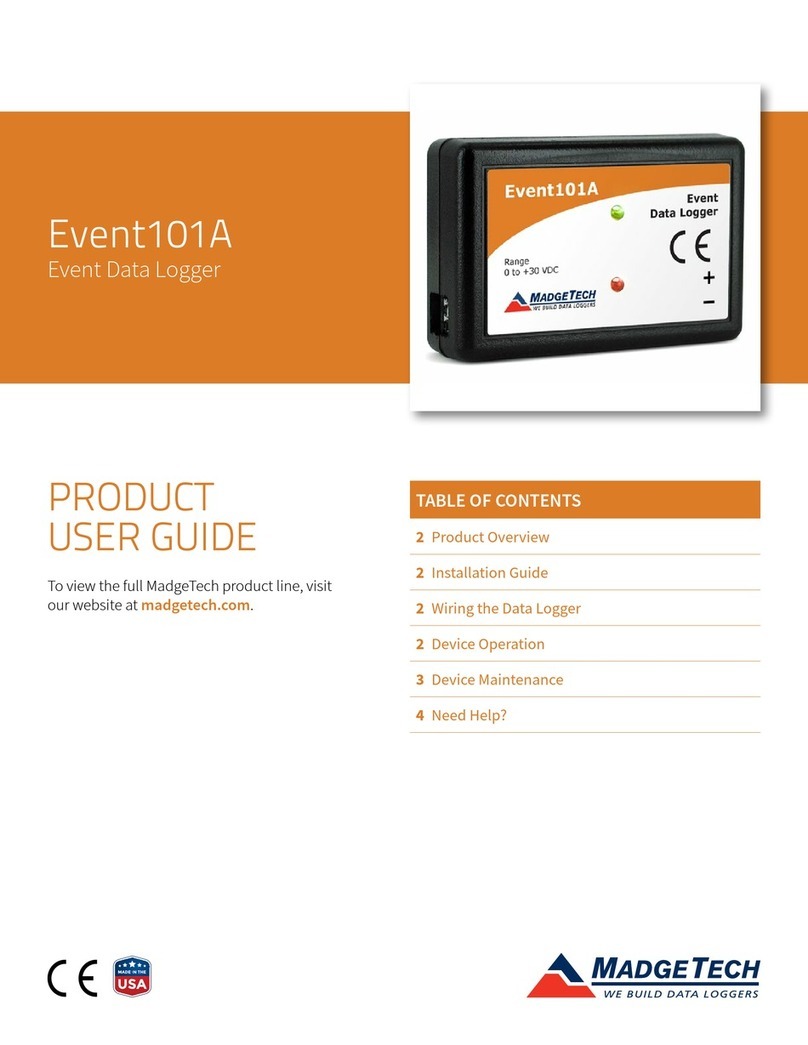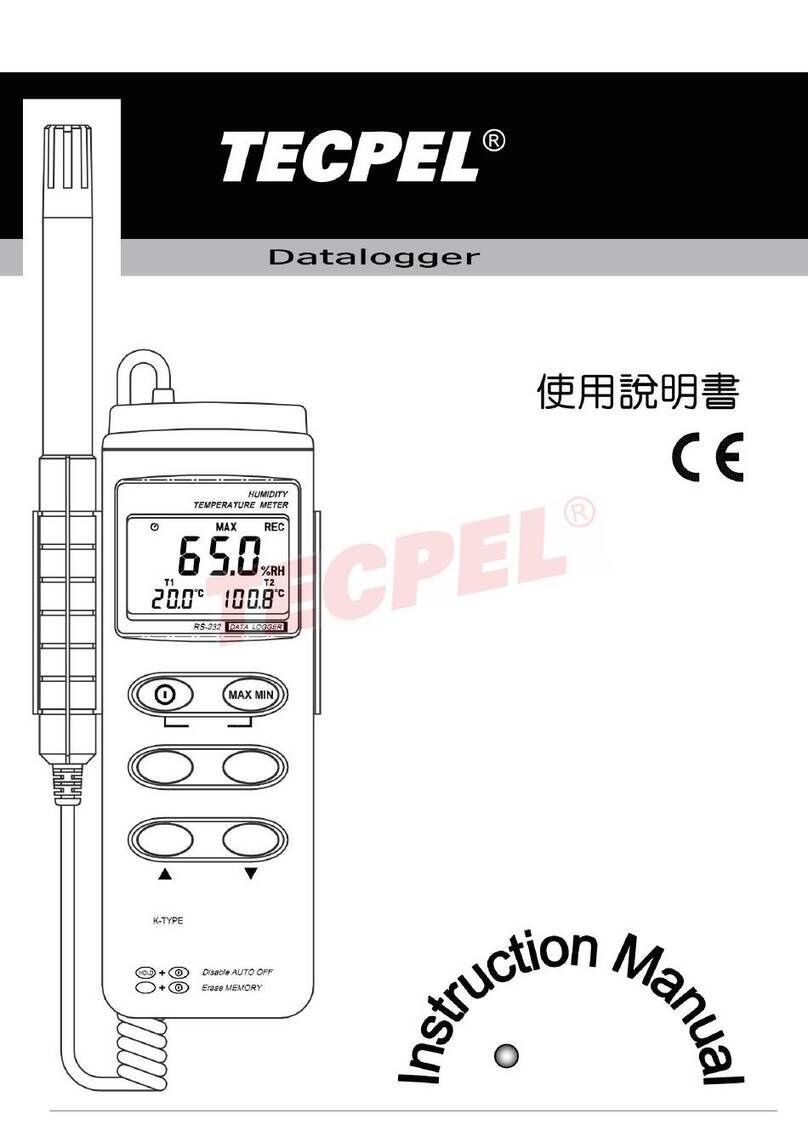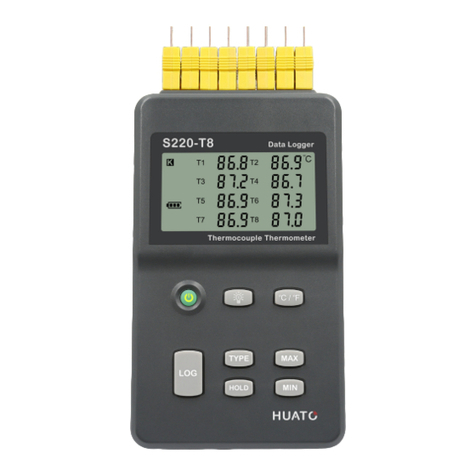Datafox KYO Inloc User manual

Manual
Datafox KYO Inloc
Flexible data collection with method

Manual Datafox KYO Inloc page II date: 16.12.2020 Version: 04.03.15.XX
© 2020 Datafox GmbH
This document has been created by Datafox GmbH and is copyrighted against third parties. Datafox
GmbH considers all contained information, knowledge and depictions as its sole property. All rights,
including also translation, reprint or copy of the whole document or parts of it, require written con-
sent of Datafox GmbH.
The assertion of all rights in this respect is reserved to Datafox GmbH, especially in case of the
grant of a patent. The handover of this documentation does not establish a claim to the license or
the use of the soft- and hardware. Copies of the floppy disks and CDs may only be made for the
purpose of data backup. Every unauthorized copy of this documentation or the Datafox software will
be prosecuted.

Manual Datafox KYO Inloc page III date: 16.12.2020 Version: 04.03.15.XX
Alterations
Alternation in this Dokument
Date
Chapter
Discription
16.01.2018
all
Revision the manual to new version 04.03.09.xx
23.02.2018
Technical data
15.07.2019
Access control
Extensions of the connection variables
14.12.2020
all
Revision for software version 04.03.15.xx
Alterations of the version
With the device generation IV a new versioning scheme has been introduced. According to this
scheme the file name of the device firmware and the setup program (DatafoxStudioIV) is composed
as follows:
Product name
XX.
Device genera-
tion
YY.
Compatibility
(which versions
can be used to-
gether)
ZZ.
Version number
(functional exten-
sion)
Build
Troubleshooting
(with a new version
the Build number is
reset)
z. B. AE-MasterIV
04.
03.
9.
04
The use of the manual depends on the version of the firmware and the DatafoxStudioIV or the
DFComDLL. Gather from the following table which manual matches which version. For different
combinations no support can be offered.
Firmware StudioIV and DLL validity
Firmware: 4.03.15.xx.
Studio: 4.03.15.xx
Dll: 4.03.15.xx
The DatafoxStudioIV is backward compatible. This means that you can configure a device with a
newer DatafoxStudioIV also older firmware, the device only supports the natural functions that are
implemented in the older firmware version. Ie, relevant to the functions that are possible, is always
the manual state that the firmware associated with the Setup equivalent. It is not possible to provide
a centering firmware configured with a stand of DatafoxStudioIV to who is older than the firmware.
recommendation:
If possible, use always the current version of DatafoxStudioIV.
What features are supported in which software versions, is from the file:
Datafox MasterIV, SW version xxx.pdf list as shown.
The file is located on the Datafox DVD and for download on the homepage. Please also note the in-
structions in each chapter in the manual. The updates are available on our website under www.da-
tafox.de download.

Manual Datafox KYO Inloc page IV date: 16.12.2020 Version: 04.03.15.XX
Inhalt
1. For your Safety 1
2. Introduction 3
2.1. Structure of the Documentation ............................................................................... 3
2.2. Guarantee Restriction ............................................................................................... 3
2.3. Typography of the Documentation........................................................................... 4
2.4. Important General Notes........................................................................................... 4
3. Intended Use and Environmental Protection 7
3.1. Regulations and Notices........................................................................................... 7
3.2. Power supply .............................................................................................................7
3.3. Environmental Influences .........................................................................................7
3.4. Mounting outdoors.................................................................................................... 8
3.4.1. Temperature................................................................................................................8
3.5. Repair......................................................................................................................... 9
3.6. Cleaning .....................................................................................................................9
3.7. Further Notices..........................................................................................................9
3.8. Disposal ................................................................................................................... 10
4. System Requirements / Hardware 11
4.1. System Structure..................................................................................................... 11
4.2. Requirements for Operating Datafox Devices....................................................... 11
4.3. General Hardware Information................................................................................ 12
4.3.1. Hardware equipment .................................................................................................12
4.3.2. Behavior in case of power failure...............................................................................12
4.3.3. UPS...........................................................................................................................12
4.4. Compatibility............................................................................................................ 13
4.4.1. Firmware File Archive (*.dfz)......................................................................................13
4.4.2. Datafox Devices and Device Firmware......................................................................13
4.4.3. Device Firmware and Device Setup...........................................................................14
4.4.4. Device Firmware and Communications DLL..............................................................14
4.4.5. Communications DLL and DatafoxStudioIV...............................................................14
4.4.6. DatafoxStudioIV and Device Setup............................................................................14
4.4.7. Update / Downgrade.................................................................................................. 15
5. Device 17
5.1. Commissioning........................................................................................................ 17
5.2. Guideline for Commissioning................................................................................. 18
5.2.1. Set-up of the device................................................................................................... 18
5.2.2. Installation of the device ............................................................................................18
5.2.3. Troubleshooting during Commissioning..................................................................... 18
5.3. Communication of Hardware V4 Devices............................................................... 19
5.3.1. Communication via USB............................................................................................19
5.3.1.1. Automatic detected connected USB to PC.................................................................20
5.3.2. Installing USB driver for Hardware V4 Devices..........................................................21
5.3.3. Communication / record transfer via USB-Stick (Host)............................................... 22
5.3.3.1. Error messages by using USB-Stick (Host)................................................................23
5.3.4. Communication via TCP / IP......................................................................................24
5.3.4.1. Communication TCP / IP via network-cable...............................................................25
5.3.4.2. Communication TCP / IP via wLAN / Wifi...................................................................26
5.3.4.3. Connection of the Terminals via TCP/IP DNS / DHCP............................................... 28
5.3.5. Communication via Cellular Network (GPRS)............................................................30
5.3.6. Communication via SMS............................................................................................ 31
5.3.6.1. Send a SMS ..............................................................................................................31
5.3.6.2. Receive a SMS..........................................................................................................32

Manual Datafox KYO Inloc page V date: 16.12.2020 Version: 04.03.15.XX
5.3.7. Communication via RS485 .......................................................................................35
5.3.7.1. Connecting the terminal via RS485 to PC..................................................................35
5.3.7.2. Connecting the Terminal via RS485 with a Comserver Lantronix...............................36
5.4. Operation with Box-Devices V4.............................................................................. 38
5.4.1. Bios Menu of Box Devices V4................................................................................... 38
5.4.2. LED status display with Box Devices V4....................................................................41
5.5. Mounting of the Box Devices.................................................................................. 42
5.5.1. Mounting on a wall.....................................................................................................42
5.5.2. Mounting with a snap clip...........................................................................................42
5.6. Connecting of the box............................................................................................. 43
5.6.1. Pin assignment of the box.......................................................................................... 43
5.6.2. Power supply of the Box............................................................................................ 45
5.6.3. Power via POE.......................................................................................................... 46
5.6.4. Modules for devices of hardware V4.......................................................................... 47
5.6.4.1. Description of the various extension modules............................................................ 47
5.6.4.2. Read the optional placement of the device ................................................................ 47
5.6.4.3. Read out important module information from the device............................................49
5.6.4.4. Connection of the individual modules......................................................................... 51
5.6.4.5. Analog inputs, 4 times analog IN ............................................................................... 51
5.6.4.6. 2 times digital out.......................................................................................................52
5.6.4.7. 1 time digital Out 1x digital IN ....................................................................................52
5.6.4.8. 4 times digital IN........................................................................................................52
5.6.4.9. RS-485 bus for access control...................................................................................53
5.7. Connection and wiring of the access control........................................................ 54
5.7.1. Configuration and structure of the Access control...................................................... 54
5.7.2. Description of Tables for Access Control 2 ................................................................ 57
5.7.4. Wiring variants for the KYO Inloc............................................................................... 60
5.7.4.1. Wiring in a star form of the access control for the KYO Inloc .....................................60
5.7.4.2. One bus for access-control, 5 relays in the KYO Inloc ...............................................64
5.7.4.3. Two RS485 Bus lines and use the relay of the reader ...............................................71
5.7.4.4. Two bus lines with KYO Oneloc and attached reader................................................74
5.7.5. Instructions for the electrician for installing the access control system.......................78
5.7.5.1. Star-shaped bus wiring..............................................................................................78
5.7.6. Access-control with Intera 2.......................................................................................80
5.7.7. Access control II with EVO Agera.............................................................................. 84
5.7.7.1. Display and operation................................................................................................84
5.7.7.2. Display for state of access control .............................................................................85
5.7.7.3. Display the number keypad .......................................................................................85
5.7.7.4. Error message...........................................................................................................85
5.7.7.5. Bios-menu .................................................................................................................86
5.7.7.6. General configuration ................................................................................................86
5.7.7.7. Display configuration .................................................................................................87
5.7.7.8. Bus configuration.......................................................................................................87
5.7.7.9. Setting the bus address of the reader for RS485 bus................................................. 87
5.7.7.10. Activate the termination resistor of the bus ................................................................ 87
5.7.8. Function extention for access control II......................................................................88
5.7.8.1. General description....................................................................................................88
5.7.8.2. Examples...................................................................................................................89
5.7.8.3. Description of the table „Action2"............................................................................... 93
5.7.8.4. Additional functions for Access Control......................................................................94
5.7.8.5. List Presence............................................................................................................. 95
5.7.9. Integration of a Burglar Detection System (BDS)....................................................... 96
5.7.9.1. Configuring up the BDS.............................................................................................96
5.7.9.2. Relays and digital inputs for controlling the BDS (Type 2).......................................... 97
5.7.9.3. Assigning codes for arming and disarming (Type 3) ..................................................98
5.7.9.4. Associating BDS sections to readers (Type 4)...........................................................99

Manual Datafox KYO Inloc page VI date: 16.12.2020 Version: 04.03.15.XX
5.7.9.5. Privileging transponders to control the BDS.............................................................100
5.7.9.6. Statuscodes.............................................................................................................101
5.7.9.7. Pre-checked online processing graph......................................................................102
5.7.9.8. Example for the BDS integration.............................................................................. 103
5.7.10. Automatic relay release upon opening of the door................................................... 104
5.7.10.1. Supervised doors.....................................................................................................104
5.7.10.2. Configuration...........................................................................................................105
5.7.10.3. Requirements for the ReaderProps entry................................................................. 105
5.7.10.4. Logical conditions implemented by the access controller.........................................105
5.7.10.5. Special case: Relays operated by time model.......................................................... 106
5.7.10.6. Configuration sample...............................................................................................106
5.7.10.7. Access control lists.................................................................................................. 106
5.7.10.8. Additional lists.......................................................................................................... 107
5.7.11. Calculation for the power supply of Access modules ............................................... 108
5.7.12. Cable length and cable cross section for access wiring ........................................... 109
5.7.13. Status messages of the access control.................................................................... 110
5.7.14. Online functions for the access control .................................................................... 116
5.7.14.1. Online via http-protocol............................................................................................116
5.7.14.2. Online via DLL connection....................................................................................... 119
5.7.15. Pre-checked mode for online/offline access............................................................. 120
5.7.15.1. Configuration of pre-checked online access control.................................................120
5.7.15.2. New Option inside the controller’s setup.................................................................. 120
5.7.15.3. Determine mode of operation of access control sub system....................................120
5.7.15.4. Sequence of operation in pre-checked online access control mode......................... 120
5.7.15.5. Confirming the pre-checked online recommendation...............................................121
5.7.15.6. HTTP interface: Method df_ao_ac2......................................................................... 121
5.7.15.7. DLL function: DFCQuitRecordExt().......................................................................... 122
5.7.15.8. Corner case: RFID transponder not present in Identification table ........................... 123
5.7.16. Function for access control U&Z (locking cylinders)................................................. 124
5.7.16.1. Design example....................................................................................................... 124
5.7.16.2. First start with locking cylinders ...............................................................................126
5.7.16.3. Assembly and disassembly of the cylinders............................................................. 126
5.7.16.4. Set up the wireless network for cylinder...................................................................127
5.7.16.5. Battery state and live time........................................................................................ 128
5.7.16.6. Change the access control master ID and knob Active Time ...................................129
5.7.16.7. Optical and acoustic signals of the U&Z locking cylinder..........................................130
5.7.16.8. Optical and acoustic signals of the U&Z door handle...............................................131
5.7.16.9. Resetting the U&Z locking cylinder .......................................................................... 131
5.7.16.10. Supported transponder technologies .......................................................................132
1.1.1.1 Service key broken / lost.......................................................................................... 133
1.1.1.2 Replace service key................................................................................................. 133
1.1.1.3 Technical data of the radio module.......................................................................... 133
5.7.17. Office mode using Uhlmann&Zacher radio locks...................................................... 134
5.7.18. Office mode implementation (Variant 1 –Secure Method)....................................... 134
5.7.18.1. Activating office mode..............................................................................................134
5.7.18.2. Operation in office mode..........................................................................................134
5.7.18.3. Revoking office mode.............................................................................................. 135
5.7.18.4. Summary................................................................................................................. 135
5.7.19. Office mode implementation (Variant 2 –Classic Method)....................................... 135
5.7.19.1. Office mode in classic mode.................................................................................... 135
5.7.19.2. Configuring classic office mode ...............................................................................136
5.7.19.3. LED and Buzzer feedback in classic office mode.....................................................136
5.7.20. Operation / activation-deactivation the Office-Mode................................................. 137
5.7.20.1. activation .................................................................................................................137
5.7.20.2. deactivation .............................................................................................................137
5.7.20.3. Remarks.................................................................................................................. 138

Manual Datafox KYO Inloc page VII date: 16.12.2020 Version: 04.03.15.XX
5.8. Data on Card .......................................................................................................... 139
5.8.1. General infomations................................................................................................. 139
5.8.2. Settings for using DataOnCard................................................................................ 140
5.8.3. DataOnCard on the access control reader............................................................... 144
5.8.4. DataOnCard and a access control reader - wiring.................................................... 145
5.9. Barcode Reader..................................................................................................... 146
6. technical date IO-Box V4 / KYO-Inloc / Mobile-Box 147
6.1. communication modules....................................................................................... 148
6.2. access modules..................................................................................................... 148
6.3. Module digital in and out....................................................................................... 148
6.4. Modules miscellaneous......................................................................................... 148
7. FAQ 149
8. Index 150

Manual Datafox KYO Inloc page 1 date: 16.12.2020 Version: 04.03.15.XX
1. For your Safety
Safety Information for Datafox Products
Attention!
The KYO Inloc must only be operated according to the instructions given in
the manual. Do no insert any foreign objects into the openings and ports.
The device must not be opened. All maintenance work must only be per-
formed by authorized specialists.
Some devices contain a lithium ion battery or a lithium battery.
Do not throw into fire!
Supply voltage: 12 Volt DC
See respective type label / technical data.
The device must only be operated with a power-limited power supply
according to EN 60950-1. If you do not observe these instructions,
the device may be damaged.
The following temperature ranges must be observed
Working area / storage temperature: -20° C bis +70° C
Mobile communications module: -20° C bis +55° C
In areas with cellphone ban, GPRS, WLAN and other cellular modems
must be turned off.
Persons with heart pacemakers:
When using the device, maintain a distance of at least 20 cm between the
heart pacemaker and the device in order to avoid possible interferences.
Turn the device off immediately if interferences are assumed.
Protection class: Observe the technical data of the respective device.
In case of laser devices of class 2, the eye is protected by the blink reflex
and/or turning reactions if you briefly and accidentally look into the laser
beam. The devices may be used without further protective measures. Nev-
ertheless, avoid looking directly into the laser beam of the laser scanner
Observe the additional notes in the chapter,
“Proper use and environmental protection”
We declare under our sole responsibility that the product described fullfills the pro-
tection requirements of European Directive 89/336 / EEC as amended by 91/236 /
EEC, 92/31 / EEC, 93/97 / EEC and 93/68 /. See the manual of the devices for the
standards. Evidence is provided by compliance with the following standards:EN
55022 : 2010
- EN 55024 : 2010 + A1 : 2015
- EN 61000 –6 –2: 2005
- IEC 61000-3-2 : 2014
- IEC 61000-3-3 : 2013
- IEC EN 60950-1 : 2006 + A11 : 2009 + A1 : 2010


Manual Datafox KYO Inloc page 3 date: 16.12.2020 Version: 04.03.15.XX
2. Introduction
Datafox data terminals have been developed to fulfill the requirements of modern personnel time
recording where users have high demands concerning flexible and elegant design. Furthermore, the
Datafox Embedded-Concept also covers access control. All relevant data can be recorded with
modern technology and be transferred to the analysis software immediately. Billings, calculations or
other analyses can be performed in a timely manner; processes can be monitored and controlled
actively. This saves time and ensures the data quality and immediacy required.
Datafox data terminals are based on the Datafox Embedded-System which is equipped with modern
technology for data collection and of course also data transfer. You make your entries comfortably
via keyboard, touch display, RFID or barcode. The device is available with GPS, GSM, GPRS, USB
etc. It fulfills all conditions for a flexible usage not only for personnel or order time recording but also
for further scopes. This constitutes a real added value. The powerful tools DatafoxStudioIV and DLL
facilitate quick and easy integration in any IT solutions. Due to scalability, numerous options are
available. You can select according to your company's requirements and only pay what you really
need.
2.1. Structure of the Documentation
The manual contains a change history as well as a general part with safety information, the intro-
duction and information concerning system requirements and system structure.
The general part is followed by the main part of the manual. It contains the chapter Product Descrip-
tion Device. In this chapter, device-specific components are described as well as the device's func-
tions.
The final part of the manual provides technical data about the device and a glossary whose purpose
it is to ensure a consistent understanding between user and manufacturer.
2.2. Guarantee Restriction
All installers are responsible for the use of the device and its accessories in accordance with its in-
tended purpose and in compliance with the applicable laws, standards and directives.
All data in this manual has been checked carefully. Nevertheless, errors cannot be excluded. There-
fore, we offer no guarantee nor accept any liability for consequences that derive from errors of this
manual. Of course we are grateful if you point out errors to us. We reserve the right to make modifi-
cations in respect of technical progress. Our general terms and conditions of business apply.
Note:
Due to DatafoxStudioIV, Datafox devices offer many functions and combinations of
functions not all of which can be tested in the case of updates. This applies espe-
cially to setups defined by you as customer. Before updating your device, please en-
sure by tests that your individual setup works without any errors. If you encounter a
problem, please inform us immediately. We will take care of the clarification of the
problem on short notice.

Manual Datafox KYO Inloc page 4 date: 16.12.2020 Version: 04.03.15.XX
2.3. Typography of the Documentation
FW ..................................................................Abbreviation for firmware (software in the device)
SW..................................................................Abbreviation for software
HW..................................................................Abbreviation for hardware
GV...................................................................Abbreviation for global variable
<Name;Software Version.pdf> ........................File names
Note:
Useful information which helps you avoiding possible mistakes during the installation,
configuration and commissioning is given here.
!
!
Caution:
Here, notes are provided which must be strictly observed. Otherwise, malfunctions of
the system will occur.
2.4. Important General Notes
!
Caution:
Use the devices only according to regulations and follow the installation, commis-
sioning and operating instructions. Installation and commissioning may only be per-
formed by authorized specialists.
Subject to technical alterations.
!
Caution:
Due to technical development, illustrations, function steps, procedures and technical
data may vary slightly.
The Datafox device has been developed for the purpose of creating a flexible and easily inte-
grated terminal for data recording serving for a great variety of applications. The device is robust
and easy to use. Due to the PC setup program, the device is quickly and easily configured for its
application field so that you save time.
Numerous optional features, such as bar code reader, transponder reader, digital inputs etc., en-
able you to use the device for:
PZE - Personnel time recording
AZE - Order time recording
BDE - Operating data recording (I/O-processing)
ZK - Access control
FZDE - Vehicle data recording / telematics
This manual describes the creation of setups with the setup program DatafoxStudioIV
without covering specific applications. Potential problems and difficulties are pointed
out.
This manual describes the functionality of the KYO Inloc and explains its characteristic features. For
example, installation, operation and equipment of the device are described.
In order to define the behavior of the device, a setup must be created. For this purpose, the Data-
foxStudioIV has been developed.

Manual Datafox KYO Inloc page 5 date: 16.12.2020 Version: 04.03.15.XX
With some practice it will be possible to create a complete compilation for the KYO Inloc within
half an hour. If you need functions that are not available, please contact us.
Note:
If you need support for the compilation of setups, we offer you our services. Due to
our extensive experience with the setup, we work very quickly and can make your
setup even more efficient through useful advices, so that the input at the device can
be performed quickly and securely.
Note:
Due to DatafoxStudioIV, Datafox devices offer many functions and combinations of
functions not all of which can be tested in the case of updates. This applies espe-
cially to setups defined by you as customer. Before updating your device, please en-
sure by tests that your individual setup works without any errors. If you still encounter
problems after thoroughly testing your setup, please inform us immediately. We will
fix the error on short notice.


Manual Datafox KYO Inloc page 7 date: 16.12.2020 Version: 04.03.15.XX
3. Intended Use and Environmental Protection
3.1. Regulations and Notices
According to the current state of the art, measures were taken to ensure that the device meets the
technical and legal regulations as well as safety standards. Nevertheless, malfunctions due to inter-
ferences through other devices can still occur.
Please observe local regulations when using the device.
3.2. Power supply
Only operate the device externally with a limited power source in accordance with EN 60950-1.
Connection voltage of the MasterIV devices: 12 to 24 volts DC
If the devices run with rechargeable batteries, note the instructions in chapter "Rechargeable Bat-
tery".
!
Caution:
In the event of non-compliance with these instructions, the device or the battery (if
any) can be damaged or destroyed!
In order to ensure maximum battery life, it is recommended to recharge the battery only after com-
plete discharge.
See respective type label of the device KYO Inloc.
3.3. Environmental Influences
Extreme environmental influences may damage or destroy the device and should be avoided. This
includes fire, extreme sunlight, water, extreme cold and extreme heat.
See respective type label of the device.

Manual Datafox KYO Inloc page 8 date: 16.12.2020 Version: 04.03.15.XX
3.4. Mounting outdoors
3.4.1. Temperature
The device has an approved temperature range of - 20 ° C to + 70 ° C.
A heater is not necessary for outdoor use.
Due to the inherent heat of the electronics and power supply, the temperatures in the unit are higher
even at ambient temperatures below -20 ° C.
Condensation water only occurs when a cold object comes into the heat and would therefore only
be an issue for mobile devices.
We recommend, if you use the devices outside, then let it running permanently. Both in terms of
temperature as well as condensation, it is recommended to not switch off devices which are used
outdoors.

Manual Datafox KYO Inloc page 9 date: 16.12.2020 Version: 04.03.15.XX
3.5. Repair
Except for the battery replacement in mobile devices, Datafox devices are maintenance-free and
must only be opened by authorized professionals. In case of defects, please contact your dealer or
the Datafox service hotline.
If a definite defect is present, you can also send the device directly to Datafox.
3.6. Cleaning
CAUTION
Risk of explosion if batteries are replaced improperly.
Dispose used batteries according to the instructions.
3.7. Further Notices
Do not expose the device to strong magnetic fields, especially during operation.
Operate the slots and connections of the device only with the appropriate intended equipment.
Ensure that the device is secured during transport. For reasons of safety, do not use the device
while driving a vehicle. Also ensure that technical equipment of your vehicle is not compromised by
the device.
In order to prevent SIM card misuse, have your SIM card blocked immediately in cases of loss or
theft of the device.
The symbols are applied by an ink
printing process. Therefore, do not
use solvents or alcohol cleaners
for cleaning.
Use only
Water, dishwashing detergent or
maximum glass cleaner.

Manual Datafox KYO Inloc page 10 date: 16.12.2020 Version: 04.03.15.XX
3.8. Disposal
Observe local regulations concerning the disposal of packaging material, used batteries and
scrapped electrical equipment.
This product complies with the EU Directive No. 2002/95/EC, its appendices and the Council Deci-
sion laying down the restrictions of the use of hazardous substances in electrical and electronic
equipment.
The device is covered by the European Directive on Waste Electrical and Electronic Equipment
which came into force on February 13, 2003 and was translated into the legislation of the Federal
Republic of Germany on August 18, 2005.
Do not dispose the device in domestic waste!
As the user, it lies within your responsibility to dispose electrical and electronic equipment via the
designated collection facilities. The correct disposal of electrical and electronic equipment protects
human life and the environment.
For more information regarding the disposal of electrical and electronic equipment, please contact
your local authorities or waste disposal companies.

Manual Datafox KYO Inloc page 11 date: 16.12.2020 Version: 04.03.15.XX
4. System Requirements / Hardware
4.1. System Structure
The system consists of the Datafox device, the DatafoxStudioIV, the communication DLL and a soft-
ware for processing the generated data.
4.2. Requirements for Operating Datafox Devices
In order to operate the Datafox device, you need a 230 V power connection for the Datafox power
supply. Depending on the main communication set, you need a corresponding transfer medium or
connection cable.
Main communication:
USB one standard USB-A to USB-micro Cable (see the chapter connection USB).
RS485 a transmission path in accordance with the EIA-485 standard (see Connection
RS485).
GSM/GPRS a distortion-free mobile connection (see Connection GSM).
WLAN WiFia distortion-free channel to an access point (802.11 b/g) within reach (see
Connection WLAN).
at least one standard Ethernet cable, no „cross over“ (see Connection TCP)
HTTP (internet) via LAN TCP/IP connection with free internet access. The data are
sent to a server.
Note:
With increasing demands on transfer rate and interference immunity, the demands
on the transmission path increase as well with regard to quality (interference immun-
ity).
Setup
Create setup
Save setup
Transfer setup to device
Software for processing the generated data
DatafoxStudioIV
Communication- DLL

Manual Datafox KYO Inloc page 12 date: 16.12.2020 Version: 04.03.15.XX
4.3. General Hardware Information
4.3.1. Hardware equipment
The devices with hardware V4 are equipped with a flash memory. Depending on the device type or
selected option with 4 or 16 MB.
For the data, the memory is used as a quasi-ring buffer. If the complete ring buffer is written to full
without the data being retrieved, the terminal reports "Memory full", please notify the admin". No fur-
ther data is stored during this time.
Data that has already been read is gradually transferred. The entire memory is always used to mini-
mize the number of accesses per individual memory cell.
An ARM microcontroller with 32-bit technology is used.
Depending on the type of device, the device has a Goldcap capacitor for buffering the time.
This ensures that the watch continues to run correctly for up to one week if the power supply is in-
terrupted.
In other devices, such as EVO 4.3 or PZE-Master V4, a buffer battery is installed in addition to the
capacitor. With this, the watch retains its value for approx. 4 years.
The exact equipment can be found in the last chapter Technical Data.
4.3.2. Behavior in case of power failure
The device boots automatically when the power supply is switched on again.
All data that was not sent or retrieved by the application software before the power failure is stored
on the device.
These are not lost. After booting, this data is available again.
4.3.3. UPS
A corresponding UPS for the V4 hardware is in preparation.
We currently recommend equipping the devices with a POE module if a "UPS" is to be used. Then
connect the devices via a POE switch and supply the switch via a standard UPS.

Manual Datafox KYO Inloc page 13 date: 16.12.2020 Version: 04.03.15.XX
4.4. Compatibility
The compatibility must be observed urgently between:
-Datafox devices and the device firmware
-Device firmware and device setup
-Device firmware and communication DLL
-Communication DLL and DatafoxStudioIV
-DatafoxStudioIV and device setup
4.4.1. Firmware File Archive (*.dfz)
Description
Device files (*.hex) of the MasterIV devices are delivered in a common firmware file archive. It has
the file extension DFZ (stands for Datafox Zip). Now simply the firmware file archives (*.dfz) are indi-
cated instead of the device files (*.hex). This applies to the DatafoxStudioIV and the DLL. The indi-
cation of device files (*.hex) is still possible.
Function of the Archive
The transfer routine of the device file selects the right file from the firmware file archive on the basis
of the hardware options available in the device. Thus, it is guaranteed that all hardware components
available in the device are supported by the corresponding firmware.
Manual Selection of a File
If you do not want to integrate the archive in your installation, you have the possibility to add single
device files from the archive to the installation.
The file format of the firmware file archive is ZIP. Hence, you can open the archive with every stand-
ard ZIP-program. Via the entry "Open With" in the context menu you can select an appropriate pro-
gram for opening the file. If necessary, you can call up a program combined with this file format to
open the file by renaming the file from DFZ to ZIP.
In the archive you find a file named "Inhalt.pdf"; it contains information which file (*.hex) of the ar-
chive matches your device. Extract the desired device file (*.hex) and rename it if necessary. A re-
naming of a file is possible at any time, because all information are in the file itself.
You can state the device file extracted before as device file in DatafoxStudioIV and at calling the
DLL function. It is still tested if the file can be loaded into the chosen device before the transfer
takes place.
4.4.2. Datafox Devices and Device Firmware
Each Datafox device has an electronic flat module. The module has specific hardware equipment
concerning the options (e.g. mobile radio, WLAN, fingerprint, ...). Due to technical conditions, differ-
ent options are mutually exclusive. Currently, not all hardware options can be supported in one firm-
ware file due to limited program memory. This means that each device with specific hardware op-
tions needs a proper firmware to support the hardware options by the software.
!
Caution:
Hardware generation V 3 is supported from version 04.02.00.x onwards. The Data-
foxStudioIV is compatible up to and including firmware version 04.01.x.y. Older ver-
sions 04.00.x.y are not supported any more.
Table of contents
Other Datafox Data Logger manuals
